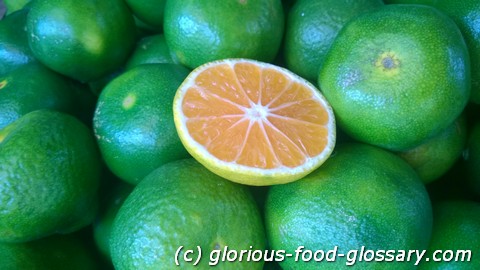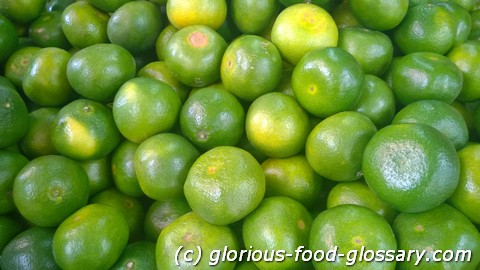Deutsch: Dalanghita / Español: Dalanghita / Português: Dalanghita / Français: Dalanghita / Italiano: Dalanghita
Dalanghita in the food context refers to a type of citrus fruit that is widely cultivated and consumed in the Philippines. It is similar in appearance and taste to tangerines and mandarins, featuring a sweet and slightly tangy flavor. Dalanghita is known for its bright orange skin, which is thinner than that of oranges, making it easy to peel. The fruit is typically small to medium in size and is segmented, with juicy flesh and few seeds, making it a popular snack and a flavorful ingredient in various dishes and beverages.
Description
The appeal of Dalanghita lies in its refreshing sweetness balanced with a mild tanginess, making it a favorite among citrus fruits for many. It is rich in vitamins, particularly vitamin C, and other nutrients, contributing to its health benefits, including boosting the immune system and promoting skin health. Dalanghita is often enjoyed fresh, either as a hand fruit or added to salads, desserts, and drinks for a burst of citrus flavor.
Application Areas
Dalanghita is versatile and can be used in various culinary contexts, including:
- Fresh Consumption: Eaten on its own as a refreshing snack.
- Juices and Beverages: Juiced to make refreshing drinks or added to cocktails and mocktails.
- Culinary Uses: Incorporated into salads, desserts, and savory dishes for added flavor.
- Candied Peels: The peels can be candied as a sweet treat or used as a garnish.
Well-Known Examples
Some well-known culinary uses of Dalanghita include:
- Dalanghita Juice: Freshly squeezed juice, often served chilled.
- Fruit Salads: Segments added to fruit salads for a sweet and tangy flavor.
- Marmalades and Jams: Made from the fruit, providing a distinct citrus taste.
Recipes
A simple recipe utilizing Dalanghita could involve making a refreshing juice:
-
Ingredients:
-
Preparation:
Treatment and Risks
Dalanghita, like other citrus fruits, is generally safe and beneficial to consume, offering nutritional value and hydration. However, individuals with certain health conditions, such as acid reflux or citrus allergies, should consume it in moderation or consult with a healthcare provider before adding it to their diet.
Similar Terms or Synonyms
- Philippine Tangerine
- Philippine Mandarin
Summary
Dalanghita is a beloved citrus fruit in the Philippines, appreciated for its sweet, slightly tangy flavor and numerous health benefits. Whether eaten fresh, juiced, or used as an ingredient in various dishes, it offers a delightful taste that enhances a wide range of culinary creations. Its nutritional profile, including a high vitamin C content, makes it a healthy addition to any diet.
--
Dalanghita is the Philippine version of Orange. It is a citrus fruit that is plump and with primarily green rind. Dalanghita is also called Sinturis and Naranghita in other parts of the country. Its scientific name is Citrus Nobilis.

Dalanghita is a Filipino word whch was adapted from the Spanish word Naranjita which means ""small orange"" : They are juicy , sometimes sweet and sometimes a bit sour. They are perfect for Philippines hot and humid weather. They can be eaten as is on hand or can be prepared as juice.

Related Articles to the term 'Dalanghita' | |
| 'Calamondin' | ■■■■■■■■■■ |
| Calamondi is another word for Calamansi or Kalamansi , the citrus fruit found in the Philippines. Calamondin . . . Read More | |
| 'Orange' | ■■■■■■■■■■ |
| Orange may refer to a citrus fruit or to the colour Orange, whixh occurs between red and yellow in the . . . Read More | |
| 'Calamansi' | ■■■■■■■■■■ |
| Calamansi in the food context refers to a small, citrus fruit native to the Philippines and other Southeast . . . Read More | |
| 'Citrus' | ■■■■■■■■■■ |
| Citrus in the food context refers to a category of fruits from the Citrus genus, known for their bright, . . . Read More | |
| 'Ugli' | ■■■■■■■■■■ |
| Ugli or Ugli Fruit refers to a citrus fruit native to Jamaica that is thought to be a cross between a . . . Read More | |
| 'Fruit' | ■■■■■■■■■ |
| Fruit refers to any product of plant growth useful to humans or animals, such as apples, pears, plums, . . . Read More | |
| 'Pumpkin' | ■■■■■■■■■ |
| Pumpkin refers to certain cultivars of squash, most commonly those of Cucurbita pepo, that are round, . . . Read More | |
| 'Dragon Fruit' | ■■■■■■■■■ |
| Dragon Fruit, in the food context, refers to the fruit of several different cactus species indigenous . . . Read More | |
| 'Samalamig' | ■■■■■■■■■ |
| Samalamig refers to a variety of traditional Filipino cold drinks and refreshments, typically served . . . Read More | |
| 'Topping' | ■■■■■■■■■ |
| Topping is any ingredient or combination of ingredients that is added to the surface of a dish to enhance . . . Read More | |
